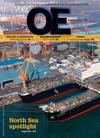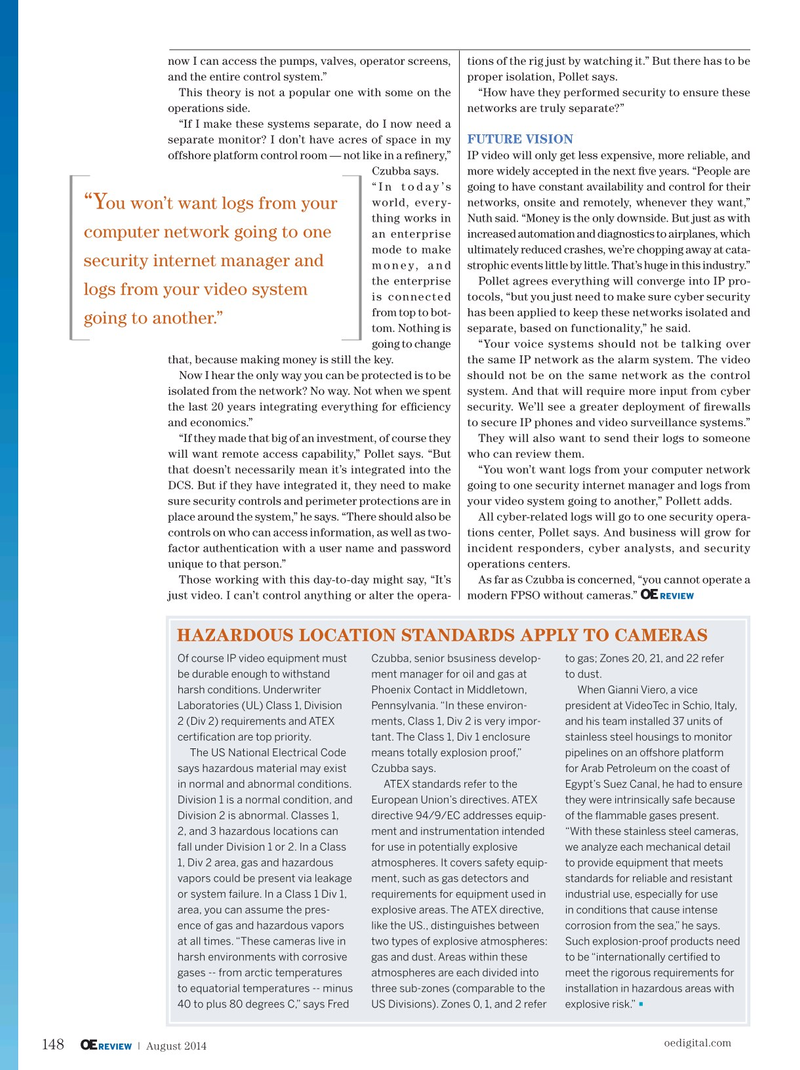
Page 146: of Offshore Engineer Magazine (Aug/Sep 2014)
Read this page in Pdf, Flash or Html5 edition of Aug/Sep 2014 Offshore Engineer Magazine
now I can access the pumps, valves, operator screens, tions of the rig just by watching it.” But there has to be and the entire control system.” proper isolation, Pollet says.
This theory is not a popular one with some on the “How have they performed security to ensure these operations side. networks are truly separate?” “If I make these systems separate, do I now need a
FUTURE VISION separate monitor? I don’t have acres of space in my offshore platform control room — not like in a refnery,” IP video will only get less expensive, more reliable, and
Czubba says. more widely accepted in the next fve years. “People are “In today’s going to have constant availability and control for their world, every- networks, onsite and remotely, whenever they want,” “You won’t want logs from your thing works in Nuth said. “Money is the only downside. But just as with computer network going to one an enterprise increased automation and diagnostics to airplanes, which mode to make ultimately reduced crashes, we’re chopping away at cata- security internet manager and money, and strophic events little by little. That’s huge in this industry.”
Pollet agrees everything will converge into IP pro- the enterprise logs from your video system tocols, “but you just need to make sure cyber security is connected has been applied to keep these networks isolated and from top to bot- going to another.” separate, based on functionality,” he said. tom. Nothing is “Your voice systems should not be talking over going to change the same IP network as the alarm system. The video that, because making money is still the key. should not be on the same network as the control
Now I hear the only way you can be protected is to be system. And that will require more input from cyber isolated from the network? No way. Not when we spent security. We’ll see a greater deployment of frewalls the last 20 years integrating everything for effciency to secure IP phones and video surveillance systems.” and economics.”
They will also want to send their logs to someone “If they made that big of an investment, of course they who can review them. will want remote access capability,” Pollet says. “But “You won’t want logs from your computer network that doesn’t necessarily mean it’s integrated into the going to one security internet manager and logs from
DCS. But if they have integrated it, they need to make your video system going to another,” Pollett adds. sure security controls and perimeter protections are in
All cyber-related logs will go to one security opera- place around the system,” he says. “There should also be tions center, Pollet says. And business will grow for controls on who can access information, as well as two- incident responders, cyber analysts, and security factor authentication with a user name and password operations centers.
unique to that person.”
Those working with this day-to-day might say, “It’s As far as Czubba is concerned, “you cannot operate a
OE REVIEW just video. I can’t control anything or alter the opera- modern FPSO without cameras.”
HAZARDOUS LOCATION STANDARDS APPLY TO CAMERAS
Of course IP video equipment must Czubba, senior bsusiness develop- to gas; Zones 20, 21, and 22 refer be durable enough to withstand ment manager for oil and gas at to dust.
harsh conditions. Underwriter Phoenix Contact in Middletown, When Gianni Viero, a vice
Laboratories (UL) Class 1, Division Pennsylvania. “In these environ- president at VideoTec in Schio, Italy, 2 (Div 2) requirements and ATEX ments, Class 1, Div 2 is very impor- and his team installed 37 units of certifcation are top priority. tant. The Class 1, Div 1 enclosure stainless steel housings to monitor
The US National Electrical Code means totally explosion proof,” pipelines on an ofshore platform says hazardous material may exist Czubba says. for Arab Petroleum on the coast of in normal and abnormal conditions. ATEX standards refer to the Egypt’s Suez Canal, he had to ensure
Division 1 is a normal condition, and European Union’s directives. ATEX they were intrinsically safe because
Division 2 is abnormal. Classes 1, directive 94/9/EC addresses equip- of the fammable gases present. 2, and 3 hazardous locations can ment and instrumentation intended “With these stainless steel cameras, fall under Division 1 or 2. In a Class for use in potentially explosive we analyze each mechanical detail 1, Div 2 area, gas and hazardous atmospheres. It covers safety equip- to provide equipment that meets vapors could be present via leakage ment, such as gas detectors and standards for reliable and resistant or system failure. In a Class 1 Div 1, requirements for equipment used in industrial use, especially for use area, you can assume the pres- explosive areas. The ATEX directive, in conditions that cause intense ence of gas and hazardous vapors like the US., distinguishes between corrosion from the sea,” he says. at all times. “These cameras live in two types of explosive atmospheres: Such explosion-proof products need harsh environments with corrosive gas and dust. Areas within these to be “internationally certifed to gases -- from arctic temperatures atmospheres are each divided into meet the rigorous requirements for to equatorial temperatures -- minus three sub-zones (comparable to the installation in hazardous areas with 40 to plus 80 degrees C,” says Fred US Divisions). Zones 0, 1, and 2 refer explosive risk.” • oedigital.com 148
OE | August 2014REVIEW 133_OE0814_OE Review.indd 148 7/23/14 12:26 AM

 145
145

 147
147